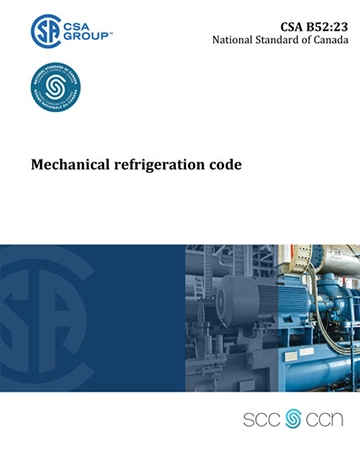Preface
This is the thirteenth edition of CSA B52, Mechanical refrigeration code. It supersedes the previous editions published in 2018, 2013, 2005, 1999, 1995, 1992, 1991, 1983, 1977, 1965, 1951, and 1939.
The thirteenth edition of this Standard provides the minimum requirements for the design, construction, installation, inspection, and maintenance of mechanical refrigeration systems, and is complemented by the practical implementation guidance CSA B52 Handbook, helping to minimize the risk of personal injury. This Standard applies to all refrigeration systems installed, whether in new or existing premises, to systems that undergo a substitution of refrigerant, and to parts that are replaced in or added to the system.
Changes to this edition include the following:
a) Clause 1.2.3 d), which excludes air conditioning in private residences from the scope of this Standard, has been deleted.
b) Clause 3 has new definitions for air circulation, connected spaces, effective dispersal volume, effective dispersal volume charge, independent circuit, mitigation actions, recycled refrigerants, refrigerant concentration limit, refrigeration detection system, refrigerant detector, releasable refrigerant charge, safety shutoff valve, system refrigerant charge, and ventilated enclosure.
c) Clause 4 has been modified to integrate ASHRAE 34 tables and procedures, update A2L references, update requirements for flammable refrigerants in public hallways, and provide new A2L requirements for human comfort.
d) Clause 5 has been revised to provide new exemptions for the registration exemption in Clause 5.2, marking and labelling requirements in Clause 5.11, addition of references to IIAR, new requirements for secondary coolant systems, and new requirements to address stress corrosion cracking.
e) Clause 6 has updated requirements for the use of A2L group refrigerants in mechanical rooms.
f) Clause 7 has updated restrictions on roof top access, and updated references regarding overpressure protection.
g) Clause 8 has a new Clause 8.4.1 on asset management planning, and new references to ASHRAE 180 to remain in alignment with the CSA B52 Handbook.
h) Clause 9 has been updated with a new Clause 9.3 for decommissioning.
i) Annex J has been updated with new provisions for dry ice formation.
j) Table L.1 has been removed from Annex L.
k) A new Annex M for frequently used refrigerants has been introduced.
l) A new Annex N provides requirements for effective dispersal volume calculations.
m) A new Annex O provides requirements for releasable refrigerant charge calculations.
n) A new Annex P provides refrigerant detection system requirements.
o) A new Annex Q provides requirements for mechanical ventilation for refrigerant safety mitigation.
Note: Given the dependency of this Standard on refrigerant data from ASHRAE Standard 34, both standards are available bundled in the CSA Store and sold together.
This Standard contains recommendations only and does not have the force of law until adopted officially by a jurisdiction. The authorities having jurisdiction, including those that have adopted this Standard, should be consulted on the extent of such adoption, as the Standard could have been adopted with exemptions or with additional requirements.
This Standard was prepared by the Technical Committee on the Mechanical Refrigeration Code, under the jurisdiction of the Strategic Steering Committee on Mechanical Industrial Equipment Safety, and has been formally approved by the Technical Committee.
This Standard has been developed in compliance with Standards Council of Canada requirements for National Standards of Canada. It has been published as a National Standard of Canada by CSA Group.
Scope
1.1 Purpose
The purpose of this Standard is to minimize the risk of personal injury by providing minimum requirements for the design, construction, installation, inspection, and maintenance of the mechanical refrigeration systems and volatile direct refrigeration systems specified in Clauses 1.2.1 and 1.2.2.
Note: This Standard does not directly address protection of property and preservation of the environment.
1.2 Application
1.2.1
Except as specified in Clause 1.2.3, this Standard applies to the design, construction, installation, inspection, and maintenance of every refrigeration system as provided for by the Act (as defined in Clause 3) and identified in this Standard.
1.2.2
This Standard applies to
a) all refrigeration systems installed subsequent to its adoption. This includes refrigeration systems installed in a new or existing premises. It also applies to all premises, including the machinery room if required, in which a refrigeration system is to be installed;
b) refrigeration systems that undergo a substitution of refrigerant in a premises defined in Item a); and
c) those parts of a refrigeration system that are replaced in, or added to, systems installed prior to its adoption.
Note: When adding or replacing parts [see Item c)], consideration should be given to the premises requirements of Item a).
1.2.3
This Standard does not apply to the following:
a) the use of water or air as a refrigerant;
b) bulk-storage gas tanks not permanently connected to a refrigeration system; and
c) refrigeration systems installed on railroad cars, motor vehicles, motor-drawn vehicles, aircraft, or ships.
1.3 Terminology
In this Standard, shall is used to express a requirement, i.e., a provision that the user is obliged to satisfy in order to comply with the standard; should is used to express a recommendation or that which is advised but not required; and may is used to express an option or that which is permissible within the limits of the standard.
Notes accompanying clauses do not include requirements or alternative requirements; the purpose of a note accompanying a clause is to separate from the text explanatory or informative material.
Notes to tables and figures are considered part of the table or figure and may be written as requirements.
Annexes are designated normative (mandatory) or informative (non-mandatory) to define their application.
1.4 Units of measurement
The values given in SI units are the units of record for the purposes of this Standard. The values given in parentheses are for information and comparison only. A list of conversion factors is provided in Annex D.
Pressure, unless otherwise stated, is expressed in kilopascals above atmospheric pressure, i.e., gauge pressure.


